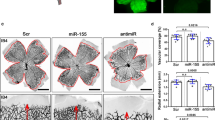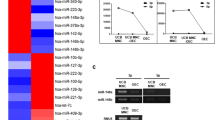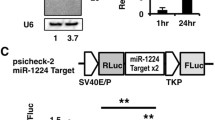Abstract
Angiogenesis involves temporo-spatially coordinated endothelial cell (EC) proliferation, differentiation, migration, and sprouting. Notch signaling is essential in regulating EC behaviors during angiogenesis, but its downstream mechanisms remain incompletely defined. In the current study, we show that miR-223-3p is a downstream molecule of Notch signaling and mediates the role of Notch signaling in regulating EC migration and sprouting. In human umbilical vein endothelial cells (HUVECs), Notch activation by immobilized Dll4, a Notch ligand, upregulated miR-223-3p, and Notch activation–mediated miR-223-3p upregulation could be blocked by a γ-secretase inhibitor (DAPT). miR-223-3p overexpression apparently repressed HUVEC migration, leading to attenuated lumen formation and sprouting capacities. Transcriptome comparison and subsequent qRT-PCR validation further indicated that miR-223-3p downregulated the expression of multiple genes involved in EC migration, axon guidance, extracellular matrix remodeling, and angiogenesis. In addition, miR-223-3p antagonist transfection abolished Notch-mediated repression of EC migration and sprouting. By quantitative reverse transcription–polymerase chain reaction (qRT-PCR), western blotting, and reporter assay analysis, we confirmed that miR-223-3p directly targeted F-box and WD repeat domain–containing 7 (Fbxw7). Meanwhile, Fbxw7 overexpression could efficiently rescue the impaired migration capacity of ECs under miR-223-3p overexpression. In summary, these results identify that Notch activation–induced miR-223-3p suppresses EC migration and sprouting via Fbxw7.







Similar content being viewed by others
References
Alabi RO, Farber G, Blobel CP (2018) Intriguing roles for endothelial ADAM10/Notch signaling in the development of organ-specific vascular beds. Physiol Rev 98:2025–2061
Autiero M, De Smet F, Claes F, Carmeliet P (2005) Role of neural guidance signals in blood vessel navigation. Cardiovasc Res 65:629–638
Bajbouj K, Ramakrishnan RK, Hamid Q (2021) Role of matrix metalloproteinases in angiogenesis and its implications in asthma. J Immunol Res 2021:6645072
Baker M, Robinson DS, Lechertier T, Barber PR, Tavora B, D’Amico G, Jones DT, Vojnovic B, Hodivala-Dilke K (2011) Use of the mouse aortic ring assay to study angiogenesis. Nat Protoc 7:89–104
Blanco R, Gerhardt H (2013) VEGF and Notch in tip and stalk cell selection. Cold Spring Harb Perspect Med 3:a006569
Chen W, Xia P, Wang H, Tu J, Liang X, Zhang X, Li L (2019) The endothelial tip-stalk cell selection and shuffling during angiogenesis. J Cell Commun Signal 13:291–301
De Bock K, Georgiadou M, Schoors S, Kuchnio A, Wong BW, Cantelmo AR, Quaegebeur A, Ghesquiere B, Cauwenberghs S, Eelen G, Phng LK, Betz I, Tembuyser B, Brepoels K, Welti J, Geudens I, Segura I, Cruys B, Bifari F, Decimo I, Blanco R, Wyns S, Vangindertael J, Rocha S, Collins RT, Munck S, Daelemans D, Imamura H, Devlieger R, Rider M, Van Veldhoven PP, Schuit F, Bartrons R, Hofkens J, Fraisl P, Telang S, Deberardinis RJ, Schoonjans L, Vinckier S, Chesney J, Gerhardt H, Dewerchin M, Carmeliet P (2013) Role of PFKFB3-driven glycolysis in vessel sprouting. Cell 154:651–663
Dou GR, Wang YC, Hu XB, Hou LH, Wang CM, Xu JF, Wang YS, Liang YM, Yao LB, Yang AG, Han H (2008) RBP-J, the transcription factor downstream of Notch receptors, is essential for the maintenance of vascular homeostasis in adult mice. FASEB J 22:1606–1617
Feng J, Chen L, Jiang Y, Tao Y (2020) The role of Apelin/APJ in a mouse model of oxygen-induced retinopathy. Invest Ophthalmol vis Sci 61:47
Fonseca CG, Barbacena P, Franco CA (2020) Endothelial cells on the move: dynamics in vascular morphogenesis and disease. Vasc Biol 2:H29–H43
Gao F, Zhang YF, Zhang ZP, Fu LA, Cao XL, Zhang YZ, Guo CJ, Yan XC, Yang QC, Hu YY, Zhao XH, Wang YZ, Wu SX, Ju G, Zheng MH, Han H (2017) miR-342-5p regulates neural stem cell proliferation and differentiation downstream to Notch signaling in mice. Stem Cell Rep 8:1032–1045
Greenspan LJ, Weinstein BM (2021) To be or not to be: endothelial cell plasticity in development, repair, and disease. Angiogenesis 24:251–269
Hoeck JD, Jandke A, Blake SM, Nye E, Spencer-Dene B, Brandner S, Behrens A (2010) Fbw7 controls neural stem cell differentiation and progenitor apoptosis via Notch and c-Jun. Nat Neurosci 13:1365–1372
Hu L, Lv X, Li D, Zhang W, Ran G, Li Q, Hu J (2021) The anti-angiogenesis role of FBXW7 in diabetic retinopathy by facilitating the ubiquitination degradation of c-Myc to orchestrate the HDAC2. J Cell Mol Med 25:2190–2202
Ji Q, Xu X, Song Q, Xu Y, Tai Y, Goodman SB, Bi W, Xu M, Jiao S, Maloney WJ, Wang Y (2018) miR-223-3p inhibits human osteosarcoma metastasis and progression by directly targeting CDH6. Mol Ther 26:1299–1312
Jiang L, Lv L, Liu X, Jiang X, Yin Q, Hao Y, Xiao L (2019) miR-223 promotes oral squamous cell carcinoma proliferation and migration by regulating FBXW7. Cancer Biomark 24:325–334
Joussen AM, Ricci F, Paris LP, Korn C, Quezada-Ruiz C, Zarbin M (2021) Angiopoietin/Tie2 signalling and its role in retinal and choroidal vascular diseases: a review of preclinical data. Eye (lond) 35:1305–1316
Karamanos NK, Theocharis AD, Piperigkou Z, Manou D, Passi A, Skandalis SS, Vynios DH, Orian-Rousseau V, Ricard-Blum S, Schmelzer CEH, Duca L, Durbee M, Afratis NA, Troeberg L, Franchi M, Masola V, Onisto M (2021) A guide to the composition and functions of the extracellular matrix. FEBS J. https://doi.org/10.1111/febs.15776
Kumar V, Palermo R, Talora C, Campese AF, Checquolo S, Bellavia D, Tottone L, Testa G, Miele E, Indraccolo S, Amadori A, Ferretti E, Gulino A, Vacca A, Screpanti I (2014) Notch and NF-kB signaling pathways regulate miR-223/FBXW7 axis in T-cell acute lymphoblastic leukemia. Leukemia 28:2324–2335
Kurashige J, Wantanabe M, Iwatsuki M, Kinoshita K, Saito S, Hiyoshi Y, Kamohara H, Baba Y, Mimori K, Baba H (2012) Overexpression of microRNA-223 regulates the ubiquitin ligase FBXW7 in oesophageal squamous cell carcinoma. Br J Cancer 106:182–188
Luo W, Garcia-Gonzalez I, Fernandez-Chacon M, Casquero-Garcia V, Sanchez-Munoz MS, Muhleder S, Garcia-Ortega L, Andrade J, Potente M, Benedito R (2021) Arterialization requires the timely suppression of cell growth. Nature 589:437–441
Muhleder S, Fernandez-Chacon M, Garcia-Gonzalez I, Benedito R (2021) Endothelial sprouting, proliferation, or senescence: tipping the balance from physiology to pathology. Cell Mol Life Sci 78:1329–1354
Phng LK, Gerhardt H (2009) Angiogenesis: a team effort coordinated by notch. Dev Cell 16:196–208
Shao J, Fan G, Yin X, Gu Y, Wang X, Xin Y, Yao Y (2019) A novel transthyretin/STAT4/miR223–3p/FBXW7 signaling pathway affects neovascularization in diabetic retinopathy. Mol Cell Endocrinol 498:110541
Shi L, Fisslthaler B, Zippel N, Fromel T, Hu J, Elgheznawy A, Heide H, Popp R, Fleming I (2013) MicroRNA-223 antagonizes angiogenesis by targeting beta1 integrin and preventing growth factor signaling in endothelial cells. Circ Res 113:1320–1330
Sun JX, Chang TF, Li MH, Sun LJ, Yan XC, Yang ZY, Liu Y, Xu WQ, Lv Y, Su JB, Liang L, Han H, Dou GR, Wang YS (2018) SNAI1, an endothelial-mesenchymal transition transcription factor, promotes the early phase of ocular neovascularization. Angiogenesis 21:635–652
Sun JX, Dou GR, Yang ZY, Liang L, Duan JL, Ruan B, Li MH, Chang TF, Xu XY, Chen JJ, Wang YS, Yan XC, Han H (2021) Notch activation promotes endothelial quiescence by repressing MYC expression via miR-218. Mol Ther Nucleic Acids 25:554–566
Taha M, Shaker OG, Abdelsalam E, Taha N (2020) Serum a proliferation-inducing ligand and MicroRNA-223 are associated with rheumatoid arthritis: diagnostic and prognostic implications. Mol Med 26:92
Tetzlaff F, Fischer A (2018) Control of blood vessel formation by Notch signaling. Adv Exp Med Biol 1066:319–338
Tiwari A, Mukherjee B, Dixit M (2018) MicroRNA key to angiogenesis regulation: miRNA biology and therapy. Curr Cancer Drug Targets 18:266–277
Wang H, Chen J, Zhang S, Zheng X, Xie S, Mao J, Cai Y, Lu X, Hu L, Shen J, Chai K, Chen W (2020) miR-223 regulates autophagy associated with cisplatin resistance by targeting FBXW7 in human non-small cell lung cancer. Cancer Cell Int 20:258
Wang R, Wang Y, Liu N, Ren C, Jiang C, Zhang K, Yu S, Chen Y, Tang H, Deng Q, Fu C, Wang Y, Li R, Liu M, Pan W, Wang P (2013) FBW7 regulates endothelial functions by targeting KLF2 for ubiquitination and degradation. Cell Res 23:803–819
Yan XC, Cao J, Liang L, Wang L, Gao F, Yang ZY, Duan JL, Chang TF, Deng SM, Liu Y, Dou GR, Zhang J, Zheng QJ, Zhang P, Han H (2016) miR-342–5p is a Notch downstream molecule and regulates multiple angiogenic pathways including Notch, vascular endothelial growth factor and transforming growth factor beta Signaling. J Am Heart Assoc 5:e003042
Yeh CH, Bellon M, Nicot C (2018) FBXW7: a critical tumor suppressor of human cancers. Mol Ther 17:115
Yuan X, Berg N, Lee JW, Le TT, Neudecker V, Jing N, Eltzschig H (2018) MicroRNA miR-223 as regulator of innate immunity. J Leukoc Biol 104:515–524
Yumimoto K, Nakayama KI (2020) Recent insight into the role of FBXW7 as a tumor suppressor. Semin Cancer Biol 67:1–15
Zhang MW, Shen YJ, Shi J, Yu JG (2020) MiR-223-3p in cardiovascular diseases: a biomarker and potential therapeutic target. Front Cardiovasc Med 7:61056
Zhou X, Jin W, Jia H, Yan J, Zhang G (2015) miR-223 promotes the cisplatin resistance of human gastric cancer cells via regulating cell cycle by targeting FBXW7. J Exp Clin Cancer Res 34:28
Funding
This study was supported by the National Natural Science Foundation of China (31671523, 31730041, 82003110) and Natural Science Foundation of Shaanxi Province (2020JQ-441).
Author information
Authors and Affiliations
Contributions
R.N.W. and Z.Y.Y. performed experiments and collected data. L.L., X.X.F., B.C., and X.Y.Z. assisted with experiments and data collection. H.H., X.C.Y., and Q.J.Z. designed the experiments and prepared the manuscript.
Corresponding authors
Ethics declarations
Ethics approval and consent to participate
The use of human samples was approved by the Ethics Committee of Xijing Hospital, Fourth Military Medical University. All human participants signed informed consent for the use of their umbilical cord biopsies. The animal experiments were permitted by the Animal Experiment Administration Committee of the Fourth Military Medical University.
Conflict of interest
The authors declare no competing interests.
Additional information
Publisher’s note
Springer Nature remains neutral with regard to jurisdictional claims in published maps and institutional affiliations.
Ruonan Wang and Ziyan Yang are contributed equally to this study
Supplementary Information
Below is the link to the electronic supplementary material.
Rights and permissions
About this article
Cite this article
Wang, R., Yang, Z., Liang, L. et al. Notch activation suppresses endothelial cell migration and sprouting via miR-223-3p targeting Fbxw7. In Vitro Cell.Dev.Biol.-Animal 58, 124–135 (2022). https://doi.org/10.1007/s11626-022-00649-y
Received:
Accepted:
Published:
Issue Date:
DOI: https://doi.org/10.1007/s11626-022-00649-y




